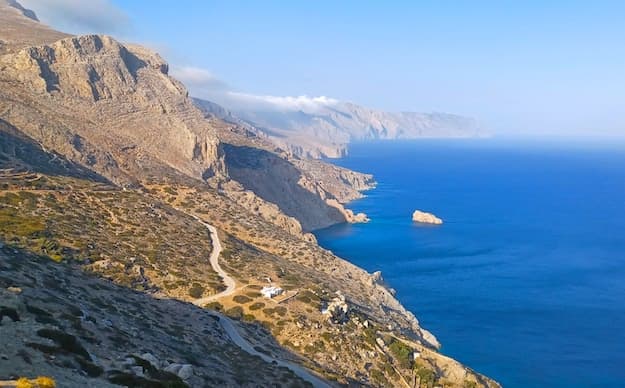Slightly Extending Summer, Free of Charge, on a Wild Greek Island
An iconic French film was shot partly at Amorgos, but that’s not the only reason to visit.

AMORGOS, Greece — French people flock to this elongated rock in the middle of the Aegean like flies to yesterday’s picnic pâté, but other than that the Greek island of Amorgos is a dulcet destination. Which is not to say sybaritic: For that kind of thing, better stick to that nirvana for many Instragrammers, Santorini, or that tough place for the frugal, Mykonos. Both crackle with Greek island clichés more than rustic Amorgos, which is almost daunting in the severity of its landscape.
Not that upon my arrival, via a swift, modern ferry from Athens, could I see all that much of it, as Amorgos was cloaked in a cool mist. That is no anomaly here, even in August: Traffic signs alert drivers to the risk of fog (intermittent) and goats (guaranteed). Only when the wisps of fog part can I see the peril of the roads I’m navigating. They trace, in one hairpin curve after another, the winding tops of cliffs that rival any along which Cary Grant ever drove a sports car.
When the sun comes out, the sea shimmers with a blue of such brilliance that no movie director could fully capture it. One did try, and with some success: In 1988, French director Luc Besson’s “Le Grand Bleu” hit the big screen. The overlong but lavishly rendered homage to the subculture of free-diving featured a prominent cast including Rosanna Arquette, Jean-Marc Barr, and Jean Reno. The real stars, though, were the seaside locations, including notably Amorgos.
The film had an enduring impact on a generation of French moviegoers. They stay at little hotels like a pension called The Big Blue, because there are no big hotels here. One could be considered medium-size. I chose my pied-à-terre, a crisp new family-owned place called Soil, because it didn’t have the words “big blue” in it and because of its prime location at the island’s chief port, little Katapola.

Port activity and a reliable power adapter are the two best friends the lone island traveler can have, and Katapola has no shortage of the former. If you have a couple grand to spare, it is worth chartering Captain Antonis’s yacht, the Maria Vek, for a day-long excursion around the coast and other smaller islands. If you don’t, for about five dollars you can hop aboard a boat that takes you to the beach at Maltezi, which is inaccessible by road.
The best beaches on Amorgos are the ones with either little sand or none at all. Paralia Agia Anna, or St. Anne’s Beach, is really more of a clearing in some sea-smoothed boulders below a tiny white Greek Orthodox chapel that gives way to waters of electric aquamarine. This was the backdrop for a scene in “Le Grand Bleu,” and the tourists come to soak it up. In the early-morning hours it is uncrowded, even in the summer.
The same principle holds for the unofficial emblem of the island, the Chozoviotissa monastery. It is perched like a cornered dove on a rock face almost a thousand feet above Paralia Agia Anna. It was built in 1017 and renovated in 1088 by a Byzantine emperor, Alexios Komnenons. This is a place where time stands so still it can be as unnerving as is the dizzying view across the Aegean.
As I clambered up the winding stone staircase, the only living creatures I encountered were two sun-worshiping kittens.
Today only two monks man the monastery, Greece’s second oldest. A resident guide told me that managing the flow of tourists can be a challenge. In terms of its beauty, Chozoviotissa rivals the Mont Saint-Michel, but here the interplay of earth, sea, and sheer altitude is more profound.
Amorgos is the easternmost of the Cycladic islands and the Romans made it part of their province of Asia. At the parking lot far below the chapel, where I was shown a silver icon of the Virgin Mary from the eighth century, I turned on my car’s radio and in between blasts of static I heard Israeli army radio and on another station a Turkish DJ spinning the latest pop hits from Istanbul.

In the classical period, Amorgos formed part of the Delian League, the grouping of Greek city-states led by Athens. Like most islands in these parts it changed hands as empires came and went, but despite long sojourns by the Venetians and Ottoman Turks, the spirit remains Greek and earthy.
Speaking of spirits, the signature Greek flavor here is Amorgion Rakomelo, an aromatic drink made from raki, honey, and eight locally grown herbs. After a stroll through the whitewashed lanes of Chora, the main inland village, I stopped at the local distillery, Amorgion, for a tasting. Of the numerous varieties my favorite was the Fragkosikomelo, a 20-proof libation infused with local prickly pear.
The apotheosis of what has come to be known as the “Greek summer” — long days at the beach followed by unhurried dinners at local tavernas that tend to start an hour or so after sunset and can easily stretch past midnight — has taken some licks in recent years. This is thanks to things like rising prices and limited accommodations. September does some repair work because while Athens is still teeming with tourists, the Greeks start making their way home.
As they do, they count their summertime swims — a tradition that no doubt started because Greece is a country with some 6,000 islands and islets. Only 223 are inhabited, but still, it is a lot. Nobody comes to this one for selfies with superyachts. You come for the watermelon and Amorgos cheese salad with grape molasses dressing served in the open air at seaside cafes with names you will not remember, and dips in crystal-clear waters the likes of which you won’t soon forget.

